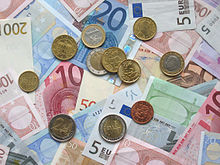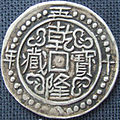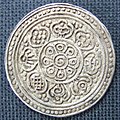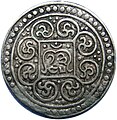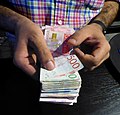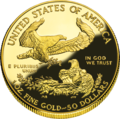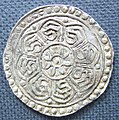The Money Portal
Money payment for goods and services and repayment of debts , such as taxes , in a particular country or socio-economic context. The primary functions which distinguish money are: medium of exchange , a unit of account , a store of value and sometimes, a standard of deferred payment .
Money was historically an emergent market phenomenon that possessed intrinsic value as a commodity ; nearly all contemporary money systems are based on unbacked fiat money without use value . Its value is consequently derived by social convention, having been declared by a government or regulatory entity to be legal tender ; that is, it must be accepted as a form of payment within the boundaries of the country, for "all debts, public and private", in the case of the United States dollar .
The money supply of a country comprises all currency in circulation (banknotes and coins currently issued) and, depending on the particular definition used, one or more types of bank money (the balances held in checking accounts , savings accounts , and other types of bank accounts ). Bank money, whose value exists on the books of financial institutions and can be converted into physical notes or used for cashless payment, forms by far the largest part of broad money in developed countries. (Full article...
Captain Euro comic book -style superhero character, created in 1999 as a way to promote the European Union , and specifically the Euro , the single European currency that arrived in 2002. The character has been featured on a website (first at captaineuro.com, later at captaineuro.eu) since 1999, but has not appeared in any actual comic books. The website's contents are available only in English.
The campaign, website and all the characters were created by
Nicolas De Santis of the consulting firm Twelve Stars (now
Gold Mercury International ) for the EU. Twelve Stars was already working for the EU in various projects, including with the
European Parliament . (
Full article... )
List of selected articles
The Latvian lats lati , plural genitive: latu , second Latvian lats ISO 4217 currency code: LVL) was the currency of Latvia from 1922 until 1940 and from 1993 until it was replaced by the euro on 1 January 2014. A two-week transition period during which the lats was in circulation alongside the euro ended on 14 January 2014. The lats is abbreviated as Ls and was subdivided into 100 santīmi (singular: santīms ; from French centime s after the santīm amount.
The Latvian lats has been recognized as one of the 99 entries of the
Latvian Culture Canon . (
Full article... )
List of selected currencies
Related portals
Get involved
For editor resources and to collaborate with other editors on improving Wikipedia's Money-related articles, see WikiProject Numismatics
Need help?
Do you have a question about Money-related content on Wikipedia that you can't find the answer to?
Consider asking it at the Wikipedia reference desk .
The following are images from various currency-related articles on Wikipedia.
Image 1 Tibetan silver tangka with Ranjana (Lantsa) script, dated 15-28 (= AD 1894), reverse (from
Tibetan tangka )
Image 2 Tibetan undated silver tangka, struck in 1953/54, obverse. (from
Tibetan tangka )
Image 3 Undated Kelzang tangka (1910), obverse (from
Tibetan tangka )
Image 4 Punch-marked coins discovered from
Chandraketugarh . (from
Punch-marked coins )
Image 5 Printing paper money at a printing press in
Perm (from
Money )
Image 6 Money Base, M1 and M2 in the U.S. from 1981 to 2012 (from
Money )
Image 7 Sino Tibetan silver tangka, dated 58th year of Qian Long era, obverse. Weight 5.57 g. Diameter: 30 mm (from
Tibetan tangka )
Image 8 US dollar banknotes (from
Money )
Image 9 A hoard of mostly
Mauryan punch-marked coins (from
Punch-marked coins )
Image 10 Tibetan "gaden" Tangka, undated (ca. AD 1840), reverse (from
Tibetan tangka )
Image 11 Undated Kelzang tangka (1910), reverse (from
Tibetan tangka )
Image 12 Tibetan "gaden" Tangka, undated (ca. AD 1840), obverse (from
Tibetan tangka )
Image 13 Tibetan undated silver tangka (2nd half of 18th century) with eight times the syllable "dza" in vartula script,reverse (from
Tibetan tangka )
Image 14 Tibetan kong par tangka, dated 13-45 (= AD 1791),obverse (from
Tibetan tangka )
Image 15 Tibetan kong par tangka, dated 13-45 (= AD 1791),reverse (from
Tibetan tangka )
Image 16 Song Dynasty
Jiaozi , the world's earliest paper money (from
Money )
Image 17 "Bent bar" minted under Achaemenid administration,
Gandhara , c.350 BC. (from
Punch-marked coins )
Image 18 Tenga of
Muhammad Khudayar Khan , struck at the Kokand mint, dated 1862–1863 (from
Kokand tenga )
Image 19 Banknotes and coins (from
Money )
Image 20 A person counts a bundle of different
Swedish banknotes. (from
Money )
Image 21 A 640 BC one-third
stater electrum coin from
Lydia (from
Money )
Image 22 A check, used as a means of converting funds in a
demand deposit to cash (from
Money )
Image 23 Paper money from different countries (from
Money )
Image 24 A 1914 British
gold sovereign (from
Money )
Image 25 President
J. K. Paasikivi illustrated in a former Finnish
10 mark banknote from 1980 (from
Money )
Image 26 Banknotes of different currencies with a face value of 5000 (from
Money )
Image 27 Tibetan undated silver tangka, struck in 1953/54, reverse. (from
Tibetan tangka )
Image 28 Sino Tibetan silver tangka, dated 58th year of Qian Long era, reverse. Weight 5.57 g. Diameter: 30 mm (from
Tibetan tangka )
Image 29 Tibetan silver tangka with Ranjana (Lantsa) script, dated 15-28 (= AD 1894), obverse (from
Tibetan tangka )
Image 30 Huizi currency , issued in 1160 (from
Money )
Image 31 Athens coin (c. 500/490-485 BC) discovered in
Pushkalavati . This coin is the earliest known example of its type to be found so far east. (from
Punch-marked coins )
Image 32 Gold coins are an example of legal tender that are traded for their intrinsic value, rather than their face value. (from
Money )
Image 33 Tibetan undated silver tangka (2nd half of 18th century) with eight times the syllable "dza" in vartula script,obverse (from
Tibetan tangka )
In the news
Categories
Select [►] to view subcategories
Category puzzle
Topics
– By region –
North Central East South West
North Caribbean Central South Proposed
Currencies of Asia
Central East North South Southeast West
European Union Eastern Southern Western
General Administration Fiscal provisions Economy International status Denominations
Coins by country with minting rights
Potential adoption by
History
General Previous EU members
Preceding currencies Former fiscal provisions
– By name –
Circulating Defunct Proposed As a denomination
Circulating Defunct As subunit See also
Circulating Circulating, Defunct Noncirculating Conceptual Virtual Fictional Private See also
Circulating Defunct Private See also
Circulating Defunct As a denomination Proposed See also
Circulating Defunct As a denomination
Circulating Defunct See also
Circulating Local alternative currency Defunct Historical antecedents (mass) See also
Circulating Subdivision
1 ⁄400 1 ⁄200 1 ⁄100 1 ⁄50 3 ⁄100 Defunct
Circulating Defunct Conceptual Fictional See also
Circulating Defunct As subunit See also
19th century 18th century 17th century 15th and 16th centuries See also
– By country –
Decimal Pre-decimal
See also
Current coins Withdrawn coins Banknote series See also
Hong Kong currency
Topics Coinage Banknotes Banknote issuers
Topics Circulating
Historical
Historical
Commemoratives
Currency and coinage of the Netherlands
Institutions Banknotes Pre-decimal guilder coins Decimal guilder coins Euro coins See also
New Zealand currency
Currency Coins Banknotes Obsolete denominations
Related topics
Current
Obsolete
Topics Ancient currencies Old currencies
Current Obsolete * Unrecognized
Topics Coins
Currency
Discontinued denominations Discontinued currency types
Related
Topics Coins Banknotes Former currencies Withdrawn coins Withdrawn banknotes
– Historical currencies –
Historical currencies of
Korea
Mun 998–1105, Yang 1892–1902 Won 1902–1910 Yen 1902–1945
Topics Coinage Banknotes Former banknotes
10 bani 25 bani 50 bani 2 lei 3 lei 25 lei 1,000 lei 2,000 lei 5,000 lei 10,000 lei 50,000 lei 100,000 lei 500,000 lei 1,000,000 lei 5,000,000 lei Former coinage
– Other –
Numismatics Exonumia See also
Wikimedia
The following Wikimedia Foundation sister projects provide more on this subject:
Commons
Wikibooks
Wikidata
Wikinews
Wikiquote
Wikisource
Wikiversity
Wiktionary
Sources
More portals
Purge server cache



